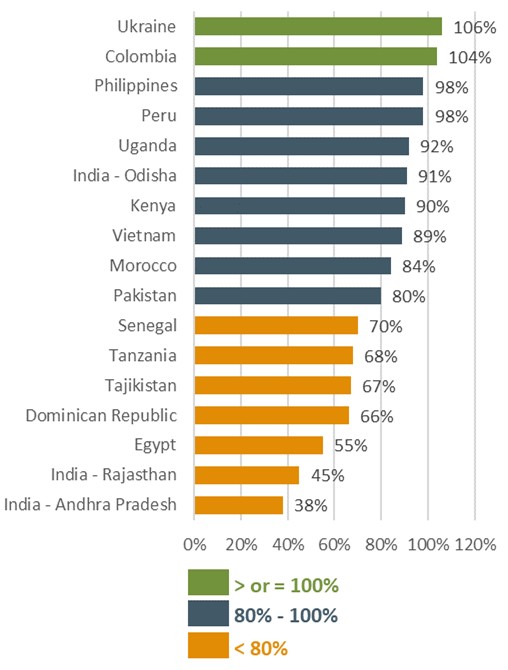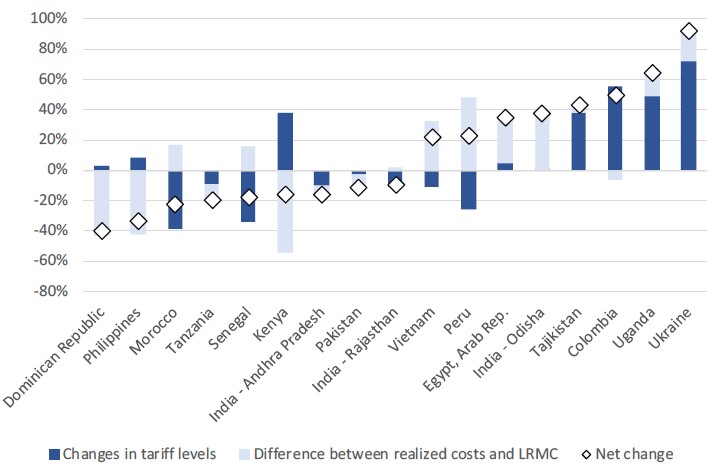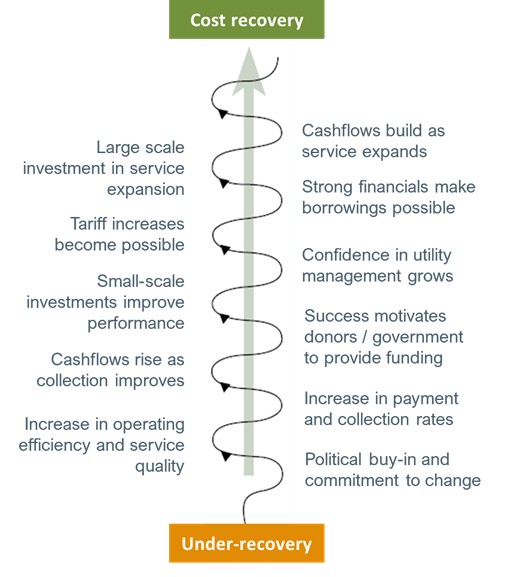ECA INSIGHT >>
Raising tariffs to cost recovery levels is often considered a prerequisite of infrastructure sector reforms. While immediate tariff increases are often publicly unacceptable and politically infeasible, case studies across the power and water sectors provide evidence that achieving cost recovery through efficiency gains which reduce the target cost recovery level and win public support is a path to financial viability and sustainable sector improvements.
Two mutually reinforcing objectives
Recovering the cost of service has long been considered a sine qua non for utilities to achieve financial viability and ensure universal access to affordable and reliable services. Cost recovery and financial viability are closely related principles and often used interchangeably although there is a conceptual difference:
● Cost recovery is achieved when the average tariff aligns with the average cost of service as measured by tariff as percentage of cost.
● Financial viability implies that total revenues (including tariffs and other sources of income) cover total costs of service delivery.
While cost recovery is an important factor, financial sustainability also crucially depends on other measures such as subsidies, government transfers and efficiency gains. A utility may be financially viable if low billing and collection losses result in stable cash inflows, even if tariffs are set below cost recovery levels and there is a regular external top-up. Similarly, even when operational cost recovery is high, utilities may struggle to be financially viable if their ability to finance service expansion is limited and/or their spending pattern is unsustainable.
Building on this conceptual distinction, the World Bank has assessed cost recovery and financial viability in power sector reforms across a wide range of developing countries[1]. The findings from 17 country case studies showed that despite efforts to improve cost recovery, tariffs are rarely high enough to cover total costs of supply, as illustrated below.
Figure 1 Average cost recovery rates (2010-17)

Source: ECA, based on World Bank (2020)
The analysis also shows that the total level of costs does not affect the extent of under-recovery. In countries where power generation and high system losses drive up costs of supply, forcing utilities to postpone network investments at the expense of service quality, customers are more likely to oppose tariff increases to recover costs. However, even when total costs are low, sensitivity around utility pricing makes tariff adjustments and/or removal of subsidies controversial. Two conclusions follow:
● Tariff reforms remain politically challenging in most countries, with under-recovery of costs being common, irrespective of whether total costs of supply are high or low.
● Increased revenues can be achieved without raising tariffs by utilities prioritising reduced costs and improved service quality, as these in turn increase payment rates and lead ultimately to financial viability.
This positive feedback loop is evident in the World Bank’s comparison of pre- and post-reform cost recovery rates (shown below), highlighting that the largest improvements for countries such as Uganda and Ukraine were driven both by increases in real tariffs and cost reductions through extensive investments to upgrade the grid, reduce losses and improve operating efficiency.
Figure 2 Full cost recovery net changes

Source: World Bank (2020)
Water sector reforms also provide case studies of efficiency gains leading to cost recovery. A good example of this positive/upward spiral is Cambodia, where the major sector restructuring following the Khmer Rouge regime delivered sustainable service improvements in operational efficiency, service quality and non-revenue water. The response from customers made possible an increase in billing and collection rates which allowed the water utility to reach full cost recovery without further increases in tariff levels.
The upward spiral to cost recovery
Reform experience across the power and water sector demonstrates that tariff increases are politically difficult, which often results in the vicious / downward spiral of under-pricing, deteriorating service quality and even lower cost recovery rates. In many countries, assistance from development partners and other institutions is conditional on tariff increases, trapping utilities in a low-level equilibrium.
To reverse this vicious cycle and embark on a sustainable development path, utilities should focus on achieving efficiency gains and improving service quality to increase payment rates and revenues. As cashflows rise and confidence in utility performance grows, various forms of funding and/or borrowing become available, enabling utilities to achieve cost recovery, gain public trust and reduce potential resistance to future tariff increases.
Strong political leadership and commitment to effect real change however remain key prerequisites to achieve sustainable improvements, as shown by the Cambodian water sector restructuring and the emerging lessons from the World Bank’s analysis. Political buy-in to push through sector reforms is the best starting point.
Figure 3 Upward spiral of utility performance

Source: ECA, adapted from SIWI (2020)
[1] World Bank (2020). Cost Recovery and Financial Viability of the Power Sector in Developing Countries – Insights from 15 Case Studies. Energy and Extractives Global Practice

Ester Vespasiani
Consultant
Ester is an economist specialised in the water and off-grid energy sectors, with a focus on policy, institutional, and regulatory frameworks. She has experience advising governments, regulators and utilities across Sub-Saharan Africa, Asia and the Pacific.
To contact Ester directly please email or connect with her on Linkedin below.
